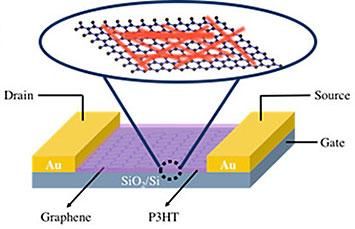The hidden Nano Power Switch
Researchers discover switching function in molecular wire
The increasing miniaturisation in electronics will result in components which consist of only a few molecules, or even just one molecule. Tiny wires are required to connect these to an electrical circuit at the nano level. An international research team from Kiel University (CAU) and the Donostia International Physics Center in San Sebastián, Spain, has developed a molecule integrating a wire with a diameter of only a single atom. The scientists discovered that the current can be regulated via this molecular wire. It works like a nano power switch, and makes the use of molecular wires in electronic components at the nano scale feasible.

This is how the wire molecule becomes a nano switch: the closer the tip of the scanning tunnelling microscope (yellow) gets to the nano wire (blue), the more the wire bends - and the current flow changes. This is due to quantum mechanical forces acting between the tip and the wire. They change the geometry of the molecule, and thereby its properties.
Copyright: Jasper-Tönnies
The wire produced by the scientists from Kiel and San Sebastián is just two atomic bonds long and one atom wide. "This is the simplest molecular wire imaginable, thinner and much shorter is not possible," explained the Kiel physicist Torben Jasper-Tönnies, first author of the publication. In order to measure the current flowing through the nano wire, both ends must be connected to a metal electrode - like with larger circuits. But there are no metal clips which are small enough to create electrical contacts at the nano scale. "Electrically contacting individual molecules in a nano circuit is a problem that has not yet been resolved satisfactorily, and is widely discussed in the research community," explained Jasper-Tönnies, who is writing his doctoral thesis in the working group of Professor Richard Berndt.
In order to enable an electrical contact, the scientists developed a new wire, consisting of only a single molecule. "The special thing about our wire is that we can install it in a vertical position on a metal surface. This means that one of the two required contacts is already effectively built-in to the wire," explained Jasper-Tönnies. To achieve this, the involved chemists used an approach from the Kiel Collaborative Research Centre (SFB) 677 “Function by Switching”. In the interdisciplinary research network, molecular platforms are among the areas of interest. The wire is attached to such a platform. It exhibits a high conductance, and can be easily attached to a metal surface like a suction cup - an electrical contact is realized.
For the second required contact, the research team used a scanning tunnelling microscope (STM). With a metal tip, it "feels" a sample, and creates an image of its surface on a scale down to a few nanometres. Individual atoms thus become visible. In their experiments, the Kiel researchers used a particularly fine metal tip for the STM, at the end of which was only a single atom. In this way, they were able to create an electrical contact with the second end of the wire, close the circuit, and measure the current. "Through this very precise contact via just one atom, we obtained particularly good data. We can replicate these contacts, and the current values measured differ very little from wire to wire," said Jasper-Tönnies.
During their measurements, the researchers also found that quantum mechanical forces act between the metal tip of the STM and the nano wire. These can be used to bend the wire mechanically. If the wire is only slightly bent, the current is reduced. However, if there is a strong bend, it increases. "By bending the wire, we were able to switch the current on or off. Although our wire is so simple, it behaves in a very complex way - this surprised us," explained Jasper-Tönnies.
The scientists think that the unusual electrical conductance of the nano wire is caused by its molecular structure. This is supported by calculations performed by Dr. Aran Garcia-Lekue and Professor Thomas Frederiksen from San Sebastián. As a result of the quantum mechanical forces, the individual atoms of the wire form new chemical bonds with the atom at the tip of the STM probe. This changes the geometry of the molecule, and thereby its properties. “Small geometrical differences can actually have a huge effect. This is why it is important to be able to set the geometry of a molecule and measure it as accurately as possible - and we achieve this by the precise contact of the nano wire and via the STM images in atomic resolution," said Jasper-Tönnies.
The publication of the researchers from Kiel and San Sebastián was highly recommended by the editors of Physical Review Letters as their "Editors' suggestion".



























































